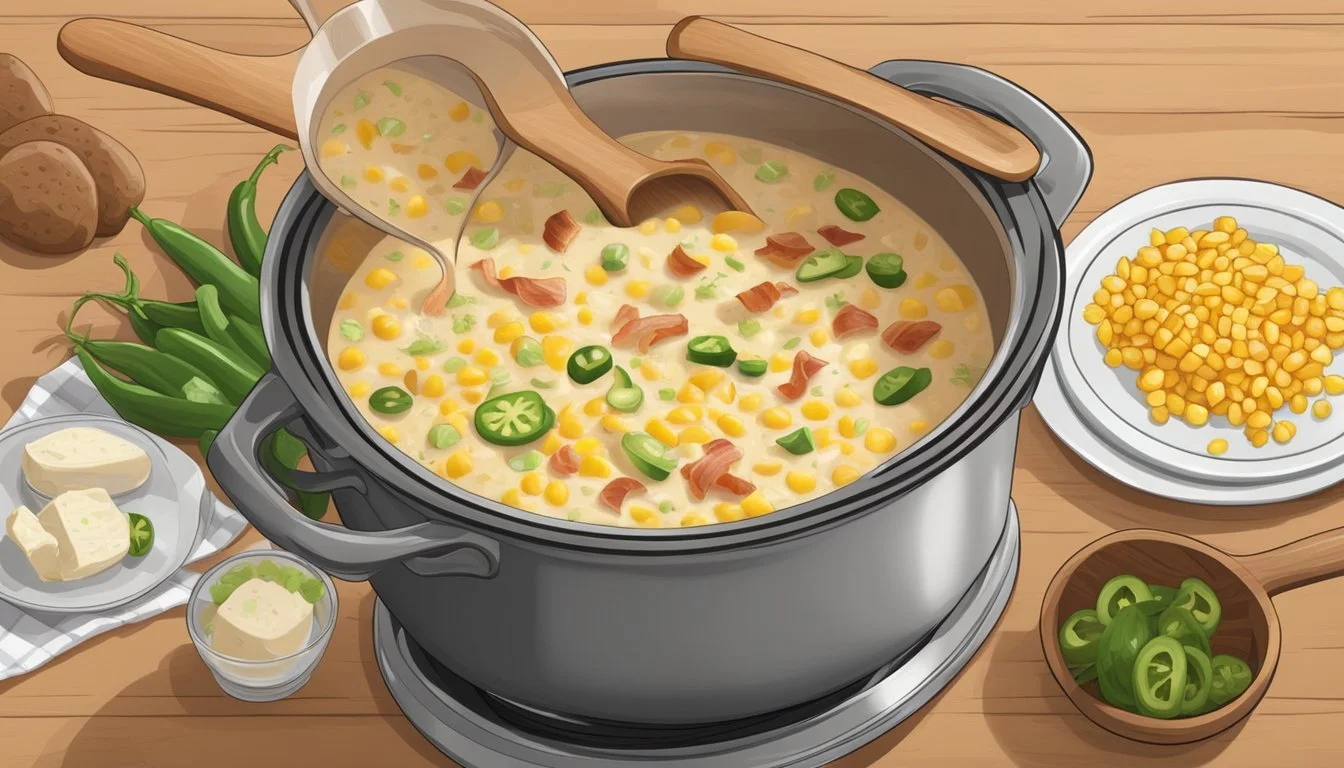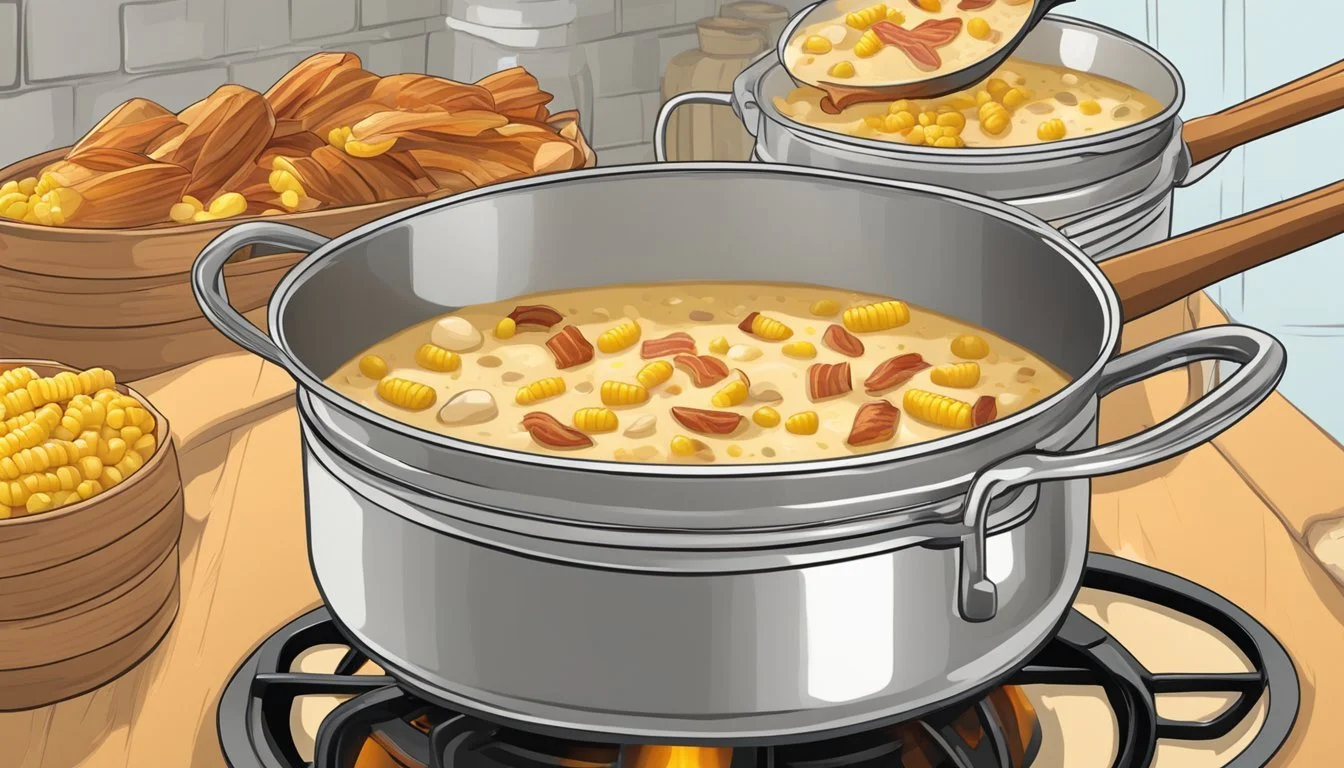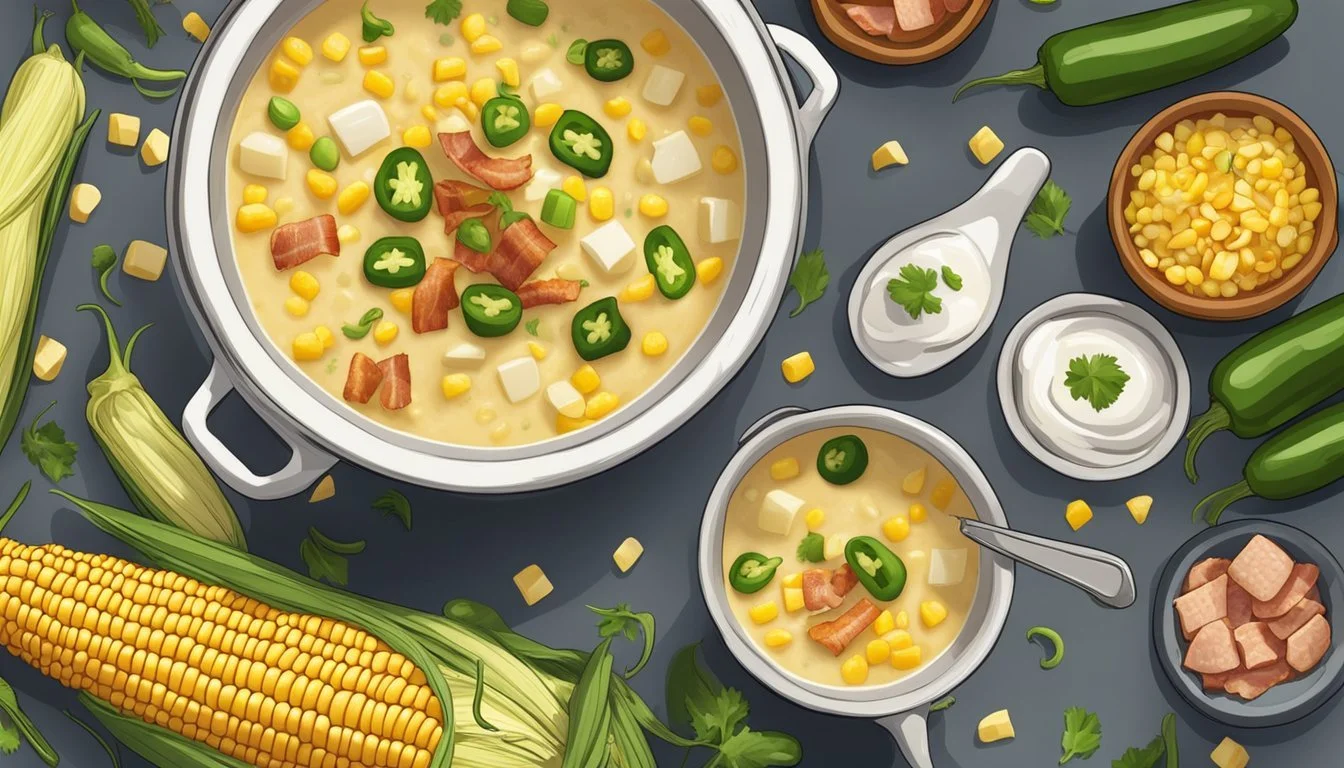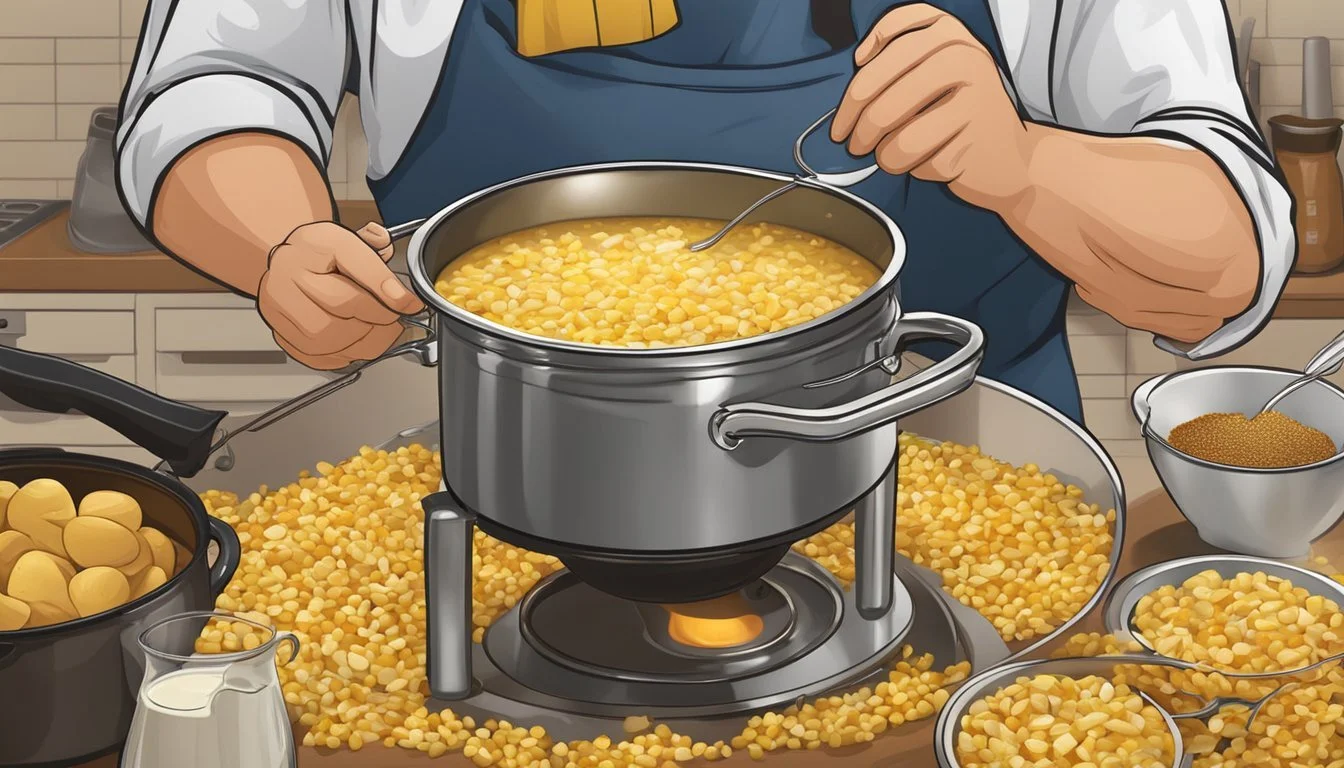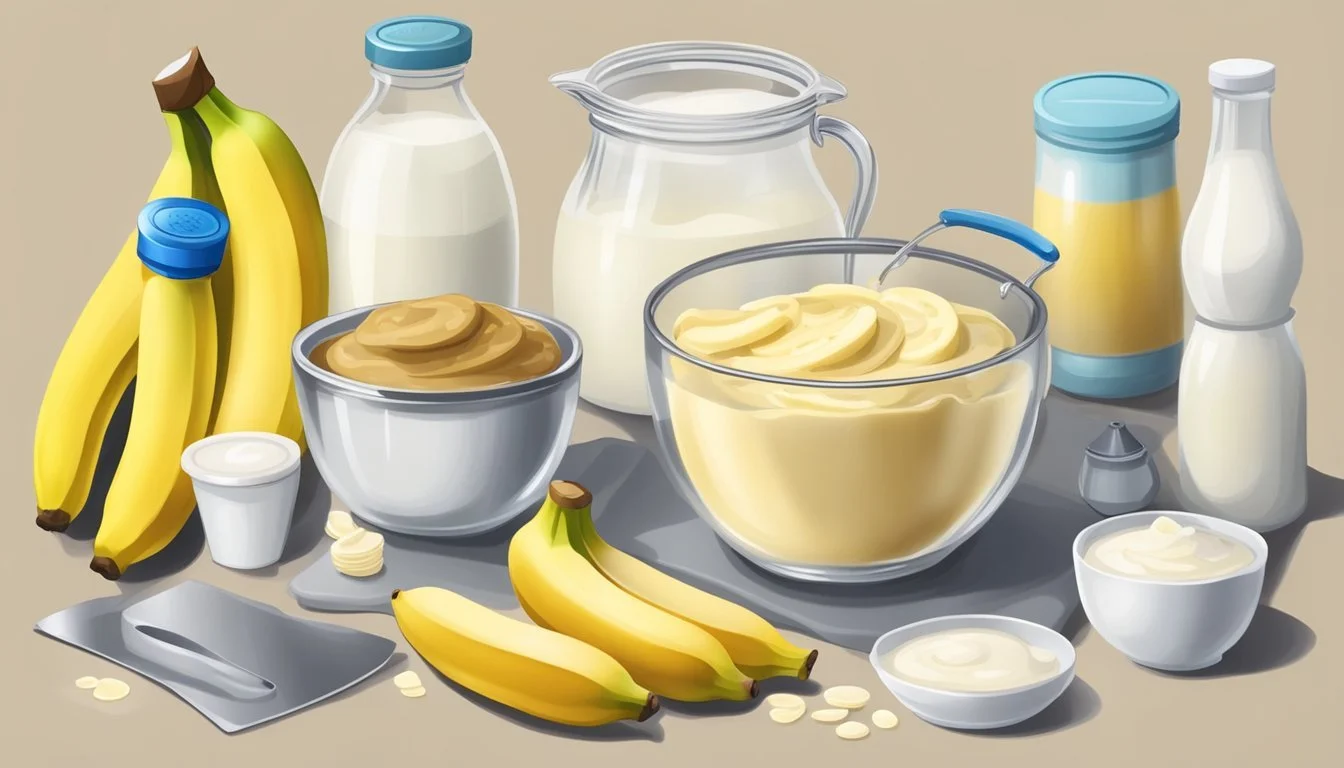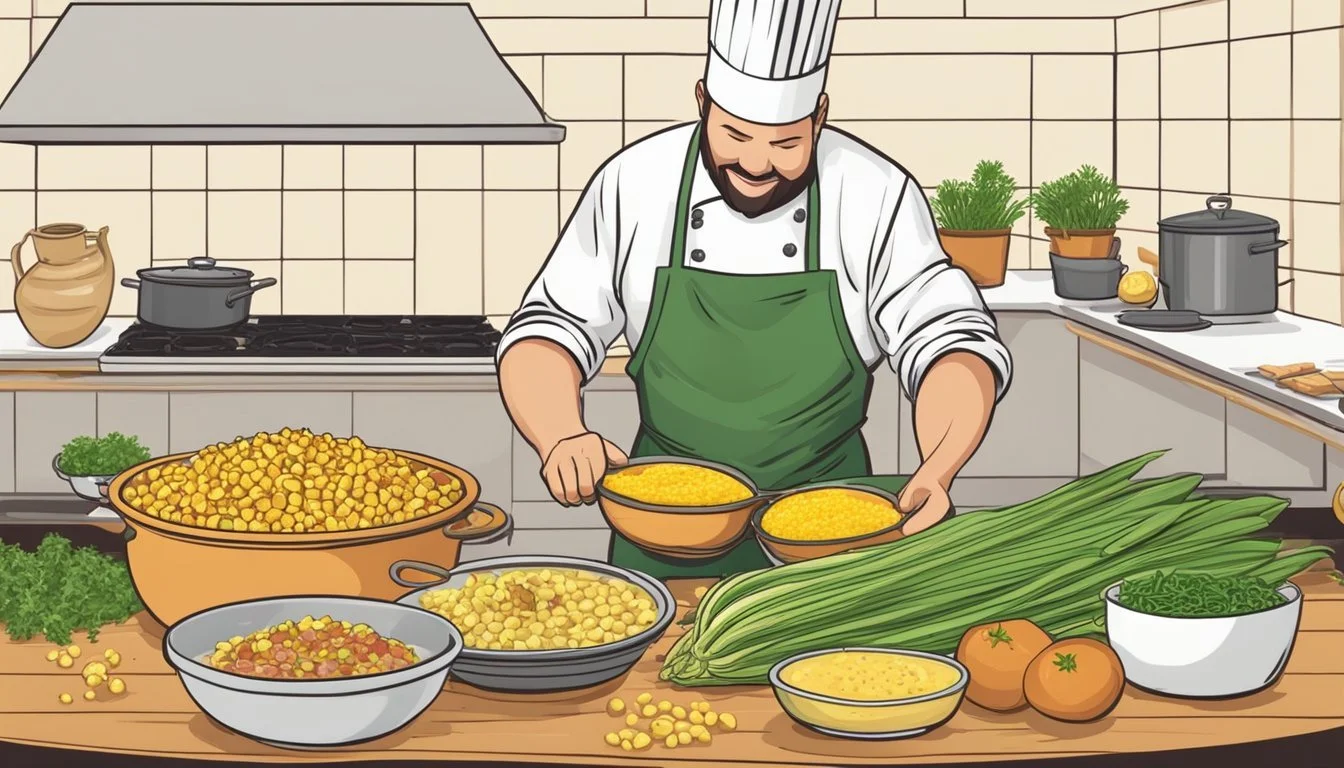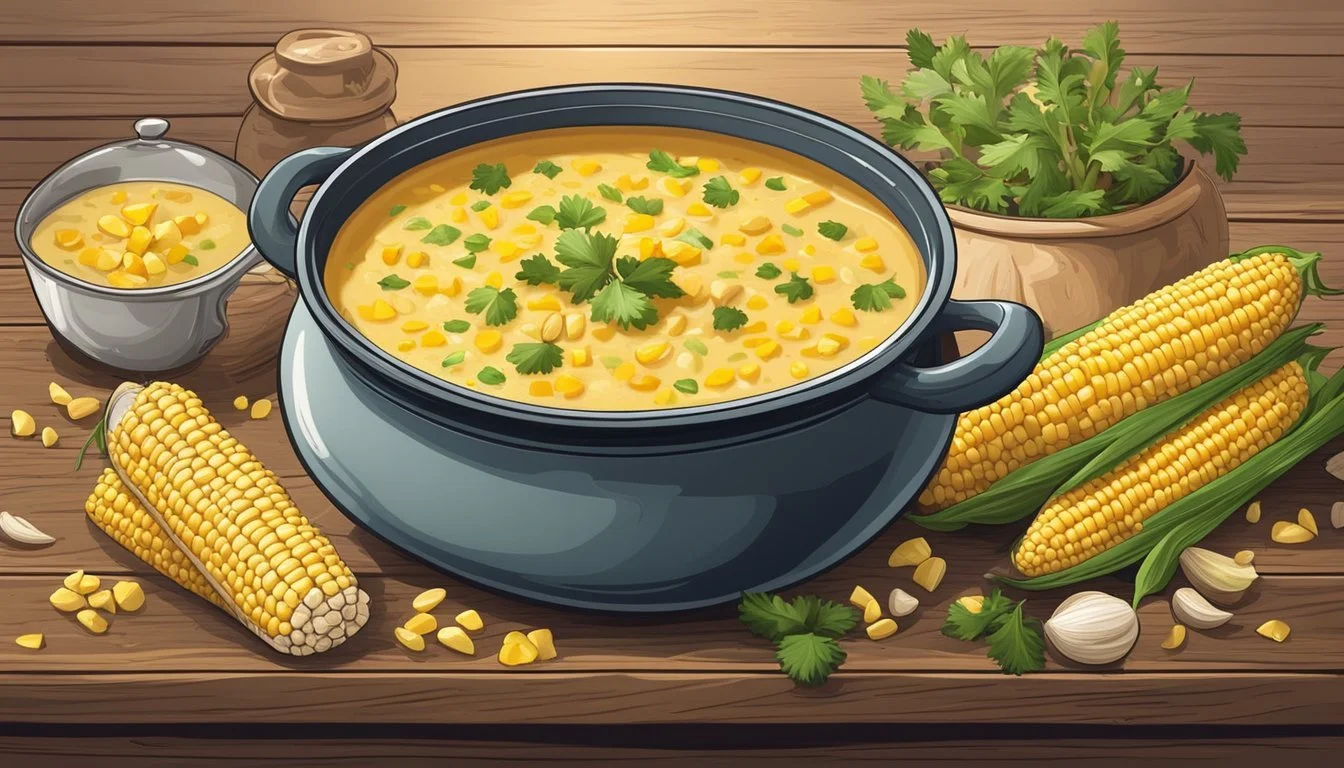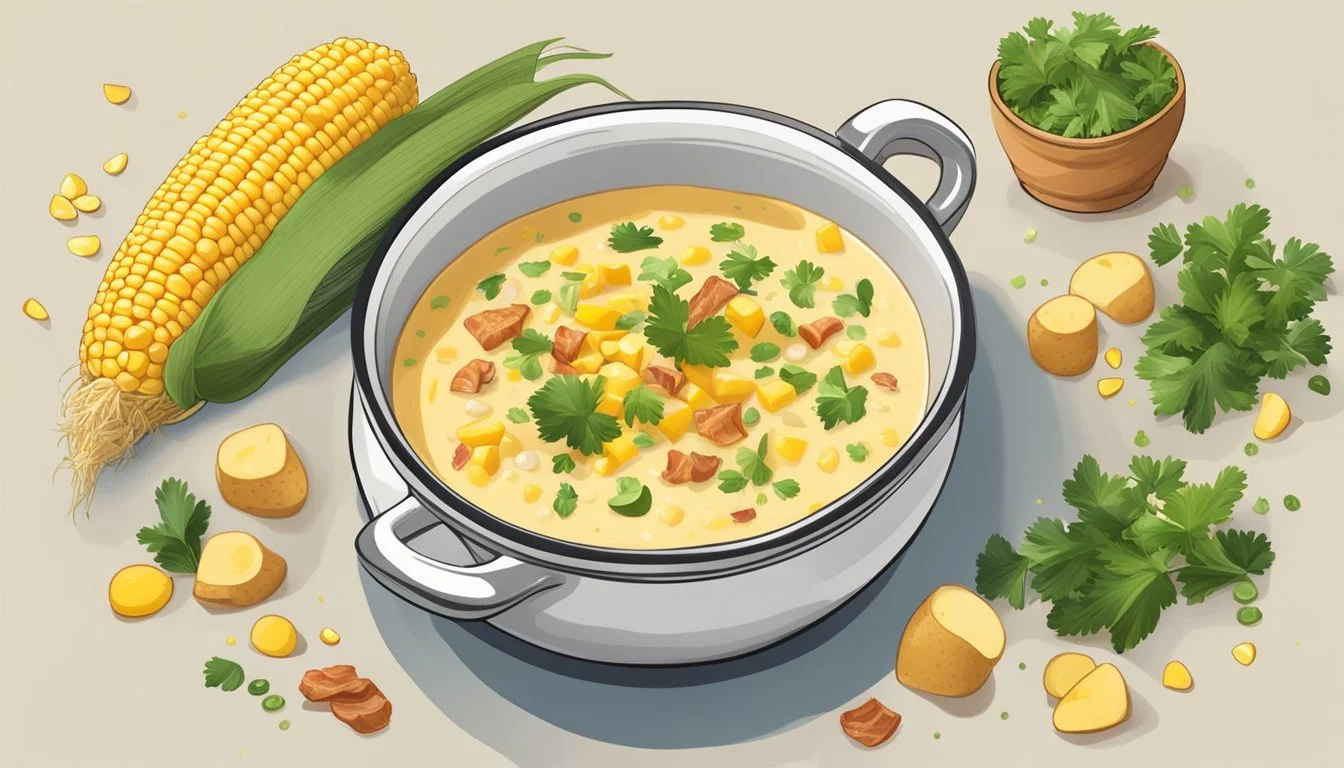How to Make a Texas-Style Corn Chowder:
Your Step-by-Step Guide
Corn (how long does corn last?) chowder embodies the comfort and richness that many associate with Southern cuisine. As a hearty soup, it provides the perfect backdrop for Texas-style ingredients to shine, coupling the sweetness of corn with a bold simplicity. Texas-style corn chowder deviates from the traditional recipe by incorporating smoked paprika, jalapeños, and a sharp cheddar topping, infusing the dish with a kick that is synonymous with the state's reputation for bold flavors.
The process of making Texas-style corn chowder starts with the creation of a flavorful base, which often includes cooking onions, bell peppers, and celery in olive oil until they are tender. Potatoes are then added to give the chowder substance and heartiness. Fresh or frozen corn kernels are simmered until just tender, adding a natural sweetness that balances the smoky and spicy elements.
To achieve the creaminess expected in a chowder while infusing it with Texan flair, many variations incorporate a mixture of milk and cream, chicken stock, and the key step of using the back of a knife to scrape the cobs, extracting the corn's milk for added depth. The finale often sees a generous addition of cheddar and a careful seasoning with salt, pepper, and chili powder, resulting in a corn chowder that is robust, comforting, and unmistakably Texan.
Essential Ingredients
When making Texas-Style Corn Chowder, selecting high-quality ingredients is crucial to achieve a balance of flavors and textures that characterize this hearty dish.
Selecting Corn
One should opt for fresh sweet corn when available, as it provides the best flavor and texture for the chowder. In off-season months, frozen corn is a suitable alternative, making sure to extend the simmering time by a few minutes to ensure proper cooking.
Choosing Proteins
Bacon is a staple protein that infuses the chowder with a smoky flavor. For a Texas twist, one may also consider adding shredded chicken. The bacon should be cooked until crisp before integrating it into the chowder, and if using chicken, it is best when cooked and shredded.
Vegetables and Aromatics
For the vegetable base, one must prepare:
Yukon gold potatoes, diced for their buttery texture,
Onion, finely chopped, for a foundational aromatic,
Red bell peppers and jalapeños, diced, to add a Texas-style kick.
These vegetables should be sautéed until tender, with olive oil serving as an optimal choice for its neutral taste and ability to withstand the sautéing process.
Liquids and Creaminess
The chowder's liquid base should consist of a rich chicken broth, which provides depth to the overall flavor. To achieve the chowder's signature creaminess, one should combine milk or heavy cream, ensuring to add it towards the end of cooking to prevent curdling. For an extra layer of flavor and texture, cheddar cheese can be melted into the chowder, and cream corn can be added for additional corn flavor.
Cooking Methods
Texas-style Corn Chowder can be perfected using various cooking methods, each offering unique benefits. The choice of a Dutch oven, slow cooker, or Instant Pot will influence the flavor development and texture of the chowder.
Traditional Stovetop Method
In the traditional stovetop method, one typically uses a Dutch oven to sauté vegetables before adding liquids and simmering ingredients. Dutch ovens are excellent for even heat distribution, which is crucial for developing flavors. Here's how to proceed:
Sauté onions, peppers, and other aromatic vegetables in the Dutch oven until softened.
Add the base liquids—stock, milk, and cream—and bring to a simmer.
Cook the potatoes and corn until tender, which usually takes around 20 minutes.
For added thickness, an immersion blender can be used to blend part of the chowder directly in the pot.
Utilizing Slow Cookers
Slow cookers are particularly good for infusing the chowder with deep, well-developed flavors over an extended period. The steps for a slow cooker are as follows:
Transfer the sautéed vegetables to the slow cooker.
Pour in broth, milk, and cream.
Cover and set to cook on low for 6-8 hours or high for 3-4 hours.
Blend with an immersion blender for a smoother consistency if desired.
Instant Pot Adaptation
For those seeking a faster process without sacrificing flavor, Instant Pots offer a modern take on chowder-making. The pressurized cooking significantly cuts down on time.
Set the Instant Pot to 'Sauté' mode to cook vegetables initially.
Add liquids and other ingredients, then seal the lid.
Cook on manual high pressure for 10 minutes followed by a quick pressure release.
Stir in dairy ingredients, and if needed, use an immersion blender for a creamy texture.
Each method requires a careful balance of heat and timing to ensure the chowder's ingredients meld into a hearty and flavorful dish.
Recipe and Instructions
The Texas-Style Corn Chowder combines the comfort of traditional corn chowder with the bold flavors of the Southwest. Below, find the detailed process for preparing this hearty dish, the specific seasonings that give it its Texan flare, and guidance on the cooking phases to ensure a perfectly simmered chowder.
Step By Step Preparation
Gather all ingredients: Before starting, ensure all ingredients are ready. This includes shucked and de-kerned corn, diced potatoes, chopped bacon, and aromatics like onion and fresh thyme.
Fry the bacon: In a heavy-bottomed pot, cook chopped bacon until crisp, then set bacon aside. Reserve some grease for sautéing vegetables.
Sauté vegetables: In the same pot, sauté diced onions and potatoes, cooking until onions are translucent and potatoes start to soften.
Seasoning and Flavoring
Add the spices: Incorporate spices such as cumin, chili powder, dried oregano, and coriander into the sautéed vegetable mix. This is where the chowder takes on its Texan identity.
Create a roux: Sprinkle flour over the vegetables and cook until it absorbs the bacon grease and coats the ingredients well. This step is crucial for thickening the chowder.
Cooking and Simmering
Add liquids and corn: Gradually pour in chicken broth and add the fresh corn kernels. Increase heat until the mixture reaches a boil.
Simmer: Reduce heat to allow the chowder to simmer. Stir in a mixture of milk or cream to enrich the chowder, then return bacon to the pot.
Cook time: Let the chowder simmer for about 20 minutes or until potatoes are tender and the soup has thickened to your liking. Adjust salt and black pepper to taste.
Remember to stir the chowder occasionally while it simmers to prevent sticking and to help flavors meld. Serve the chowder hot, garnished with fresh thyme for an aromatic finish.
Nutritional Aspects
Texas-Style Corn Chowder is a flavorful and hearty dish with significant nutritional components. Understanding the caloric content and dietary considerations of the ingredients can help individuals tailor the recipe to meet their specific nutritional needs.
Caloric Content
The caloric content of Texas-Style Corn Chowder can vary based on the ingredients used. A typical serving made with whole milk, bacon, chicken, and vegetables can range from 300 to 500 calories, with the bulk of the calories coming from carbohydrates and proteins. The addition of toppings or variations in the recipe—such as using cream instead of milk—can alter the calorie count.
Dietary Considerations
Sodium: Texas-Style Corn Chowder often has a moderate to high sodium content, particularly if store-bought broths or canned ingredients are used. One can reduce the sodium by opting for low-sodium broths and fresh ingredients.
Protein: The chicken and bacon in the chowder contribute to its protein content, offering roughly 15-25 grams per serving. These proteins are essential for muscle repair and growth.
Carbohydrates: Being corn-based, the chowder is rich in carbohydrates, which provide energy. However, using cream or milk also adds sugars to the dish.
Saturated Fat and Cholesterol: Bacon and whole milk increase the levels of saturated fat and cholesterol. To lower these, one can use low-fat milk and omit the bacon.
Vegetarian Options: For those following a vegetarian diet, the chicken and bacon can be omitted, and vegetable broth can be used instead of chicken broth. This alteration can also reduce saturated fat and cholesterol content.
When making Texas-Style Corn Chowder, individuals should consider their dietary restrictions and nutritional goals. Modifications can easily be made to accommodate different dietary needs without compromising the rich, comforting essence of the dish.
Serving Suggestions
When presenting a Texas-style corn chowder, the choice of toppings and side accompaniments can elevate the dining experience significantly. Details matter—the right additions not only complement the robust flavors but also introduce varied textures and colors to the dish.
Toppings and Add-Ons
A Texas-style corn chowder becomes even more delightful with an assortment of toppings that guests can choose from. Here are some indispensable options:
Cheese: A sprinkle of grated cheddar or a dollop of pepper jack queso can add a creamy, tangy element.
Scallions: Finely chopped scallions impart a sharp, fresh flavor that contrasts nicely with the sweet corn.
Avocado: Slices of ripe avocado contribute a rich, buttery texture that balances the chowder's heartiness.
Sour Cream: A spoonful of sour cream on top adds a cool, tangy note and creates a visually appealing swirl.
Tortilla Chips: Crushed tortilla chips provide a crunchy contrast to the creamy chowder and nods to the dish’s southwestern roots.
Accompaniments
To serve alongside the chowder, consider these options:
Crusty Bread: A slice of warm, crusty bread is perfect for soaking up the flavorful broth.
Salad: A light, crispy salad with a vinaigrette dressing can offset the chowder's richness and refresh the palate between bites.
Steamed Vegetables: A side of vibrantly colored vegetables such as steamed broccoli or sautéed zucchini complements the chowder and adds nutritional balance to the meal.
Each serving should be treated as a canvas for guests to customize their bowl of chowder to their liking with a selection of these toppings and sides.
Storing and Reheating
Maintaining the quality of Texas-style corn chowder when storing and reheating is crucial to enjoying its hearty flavors at a later time. Proper storage techniques prevent spoilage, while best reheating practices ensure the chowder's texture and taste remain as intended.
Proper Storage
When storing Texas-style corn chowder, one should transfer the cooled chowder into an airtight container. These containers not only prevent the chowder from absorbing other flavors from the refrigerator but also ensure the longevity of the soup. Ideally, the chowder should be consumed within 3-4 days when refrigerated.
Refrigerator storage tips:
Cool the chowder to room temperature before refrigerating.
Use shallow containers to allow the chowder to cool uniformly.
Seal the container with a tight-fitting lid to prevent leakage and contamination.
Best Reheating Practices
To reheat Texas-style corn chowder, a gentle and slow approach is best to preserve its creamy consistency and avoid separation of the milk or cream base. One can reheat the chowder on the stove or in a microwave.
Stovetop reheating:
Step Instructions 1 Place the chowder in a pot. 2 Heat it on a low to medium setting. 3 Stir occasionally to avoid sticking and scalding.
Microwave reheating:
Transfer a portion of the chowder to a microwave-safe bowl.
Cover it with a microwave-safe lid to avoid splattering.
Reheat in short intervals of 30 seconds, stirring in-between to ensure even heating.
In both cases, ensure the chowder reaches a temperature of 165°F (74°C) before serving. Avoid boiling the chowder to retain its flavor and texture. Heating only the amount needed at one time is recommended as repeated reheating can degrade quality.
Visual Presentation
When preparing a Texas-Style Corn Chowder for photography, one should emphasize the dish's vibrant colors and hearty texture. Proper lighting and arrangement can turn a simple bowl into a feast for the eyes.
Photography Tips for Bloggers
To capture the essence of Texas-Style Corn Chowder:
Lighting: Utilize natural light to best highlight the chowder’s creamy base and the bright yellow of the corn. A diffuser can soften harsh sunlight, reducing unwanted shadows.
Angles: Shoot from above to show the chowder’s consistency and ingredients distribution. A close-up angle can showcase the textures and colors of the corn, bacon, and potatoes.
Styling: Add a spoon on the side or a sprinkle of chopped parsley to introduce a pop of color and a homely feel. Accents like rustic bread or a napkin can add warmth and context to the photograph.
Background: Choose a background that contrasts with the chowder to make the colors stand out. A dark wooden table or a simple solid-colored cloth can work well.
By focusing on these aspects, a blogger can take photographs that are as appealing as the chowder itself, encouraging readers to try the recipe.
Additional Information
In this section, we provide tailored advice for customizing your Texas-style corn chowder and answers to common queries that may arise during preparation.
Making It Your Own
One can personalize this all-inclusive soup recipe to match their palate or to utilize ingredients already in their pantry. A few modifications include:
Proteins: For a heartier meal, one might add cooked chicken or rotisserie chicken; consider shrimp for a coastal twist, or ham for a smoky depth.
Corn: While fresh corn offers a delightful crunch and natural sweetness, frozen corn is a convenient alternative that doesn't sacrifice flavor. If in a pinch, canned corn can serve as a quick substitution.
Vegetables: To enhance the soup's complexity, think about incorporating colorful veggies such as red pepper, carrots, or a jalapeno pepper for a kick.
Beans: Black beans can be added for extra protein and a nod to Tex-Mex cuisine.
Creaminess: Achieving the desired richness is easily done with half and half, though those seeking a lighter version might opt for milk or a milk alternative.
Flavor Boost: For deeper savoriness, fresh herbs (how long do fresh herbs last?) or green chiles lend their distinctive notes to the chowder.
Common Questions
Q: Can I make corn chowder for a quick lunch? A: Absolutely. This easy soup can be prepared in advance and reheats well, making it a convenient option for lunch.
Q: How do I thicken my corn chowder? A: To thicken the chowder, one could use a roux made from flour and butter or add a slurry of cornstarch and water. Simmering the soup with potato soup elements such as mashed potatoes can also lend creaminess and body.
Q: What if I don’t have fresh herbs? A: Dried herbs can be used in place of fresh. Remember to use them sparingly as they have a more concentrated flavor.
Q: Is Texas-style corn chowder suitable for dinner parties? A: This versatile soup recipe is an excellent choice for dinner gatherings. It's a comforting dish that can be largely prepped ahead of time, allowing hosts to spend more time with guests.
Conclusion
When preparing Texas-Style Corn Chowder, one appreciates the harmony of flavors achieved by incorporating traditional Southwestern ingredients. A careful balance between the smokiness of the bacon, the sweetness of the corn, and the savory depth of the chicken broth underpins the success of this dish. Attention to the cooking times ensures that each component, from the tender potatoes to the perfectly browned venison (What wine goes well with venison?), contributes its unique texture and taste to the final presentation.
The key steps to remember include:
Sautéing vegetables until tender but not browned.
Simmering the mixture to allow flavors to meld.
Adding fresh or good quality canned corn for a sweet, crisp contrast.
In terms of nutritional value, the chowder provides protein from the venison and a range of vitamins and minerals from the corn and other vegetables. It's a hearty meal that can be enjoyed across all seasons, serving it hot in the winter for a cozy effect or slightly chilled in the summer months for a more refreshing take.
Texas-Style Corn Chowder stands out for its distinctive Southwestern flair and the versatility it offers. One can adjust seasoning levels or add additional ingredients like chiles or cilantro to personalize the dish further. Remember, the chowder’s robustness and warmth make it a worthy centerpiece for a family dinner, potluck, or any gathering where comforting food is celebrated.

